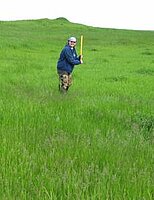Evaluation of an Index of Plant Community Integrity for Assessing Wetland Plant Communities in the Prairie Pothole Region
Christina L.M. Hargiss is a M.S. (Natural Resource Management) student at North Dakota State University (NDSU) Fargo, North Dakota. Christina graduated from Maddock High School in 1998. During this time a seed of interest in wetlands and environmental education was started. Christina attended NDSU and further developed her interest by triple majoring in Natural Resource Management, Biological Science Education, and Comprehensive Science Education. As an undergraduate she worked in the Zoology Department at NDSU researching macroinvertebrates and water quality. For her Master’s Degree she decided to expand her knowledge and chose a project focused on the health of wetland plant communities.
Fellow: Christina Hargiss, Department of Animal and Range Sciences, NDSU
Advisor: Dr. Don Kirby, Interim Chair of the Department of Animal and Range Sciences, NDSU
Matching Support: North Dakota Department of Health, NDSU
Degree Progress: M.S. expected in December 2005
Evaluation of an Index of Plant Community Integrity for Assessing Wetland Plant Communities in the Prairie Pothole Region
Since the implementation of the Clean Water Act in 1972 (Public Law 92-500) there has been increased effort to restore and maintain our nation’s wetlands. Legislation since this Act, accompanied with a wide range of land uses within the Prairie Pothole Region (PPR), has resulted in the EPA and other government agencies trying to answer the question of how to assess the health of a wetland.
Efforts were made by the Natural Resources Conservation Service (NRCS) and the US Army Corps of Engineers (COE) to answer this question when they created the Hydrogeomorphic (HGM) Model for wetland functional assessment. Another attempt to answer this question was through the creation of the Index of Biological Integrity (IBI) for biological assessment. This was a joint venture of the EPA and several state agencies.
DeKeyser et al. (2003) developed an IBI for seasonal wetlands in the PPR that they termed the Index of Plant Community Integrity (IPCI). An IPCI has also been developed to quantitatively assess the condition of temporary and semi-permanent wetlands of the Northwestern Glaciated Plains (NWGP) ecoregion (DeKeyser 2000, Kirby and DeKeyser 2003). The NWGP ecoregion is within the mixed grass prairie of North Dakota. Wetland assessment was based on disturbance level and multiple vegetative composition measurements. This classification allows for other temporary, seasonal, and semi-permanent wetlands in the NWGP to be classified and placed into quality classes for mitigation and ecological purposes.
The DeKeyser (2000), DeKeyser et al. (2003), and Kirby and DeKeyser (2003) research was found useful in the NWGP of the PPR. However, it is not known whether it is applicable to other ecoregions of the PPR, and whether it is reliable through major climatic disturbances such as droughts. In the current study, the research area was extended to include more of the PPR, specifically the entire NWGP and Northern Glaciated Plains (NGP) of South Dakota, the NGP of North Dakota, and the NWGP of Montana (Omernik 1987). In addition to ecoregion, assessment wetlands were chosen based on the level of disturbance in the wetland and surrounding area, and under a wider range of disturbances including drought. These measurements will help to evaluate the IPCI’s effectiveness over a larger geographic area, and over a larger disturbance gradient.
Project Objectives:
The specific objectives of this study include:
- Evaluate the IPCI assessment technique over a larger spatial area within the PPR.
- Evaluate the IPCI assessment method based on a wider variety of disturbances.
- Validate the metrics, quality classes, and assessment methods used in the IPCI.
- Determine if/how the HGM Model can be incorporated into the IPCI to evaluate wetland condition.
Progress to Date:
Data was collected during the summers of 2003 and 2004. Data was analyzed during 2005. Thesis has been written and defense of thesis is completed. Thesis is currently under revision with The Graduate School. Analyses of data showed that the IPCI proved to be an effective tool for evaluating the health of wetland plant communities in the NGP and NWGP of North Dakota, South Dakota, and Montana. Specific metric ranges were changed to better suite a larger data set when compared to the original IPCI. The HGM Model was not able to evaluate wetlands consistently with the IPCI.
Significance:
The IPCI can be used by private landowners, agencies, and land managers for providing baseline data by identifying and assessing wetland plant communities. Also, the IPCI can be used in restoration efforts to monitor change year to year. The IPCI can also be used in reclaimed areas and for mitigation purposes.

Don Kirby
Animal and Range Sciences
North Dakota State University



